Anubis › Punt » Ancient origins
Articles and Definitions › Contents
- Anubis › Who Was
- Punt › Antique Origins
Ancient civilizations › Historical and archaeological sites
Anubis › Who Was
Definition and Origins
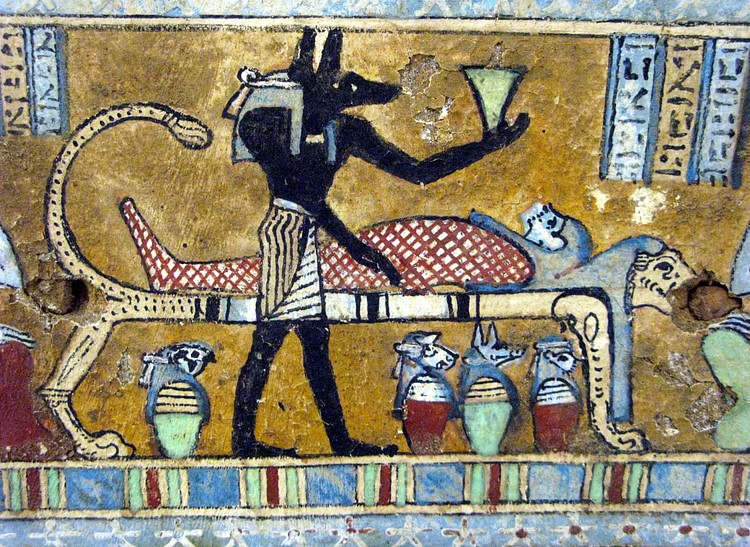
Anubis is the Egyptian god of mummification and the afterlife as well as the patron god of lost souls and the helpless. He is one of the oldest gods of Egypt, who most likely developed from the earlier (and much older) jackal god Wepwawet with whom he is often confused. Anubis' image is seen on royal tombs from the First Dynasty of Egypt (c. 3150-2890 BCE) but it is certain he had already developed a cult following prior to this period in order to be invoked on the tomb 's walls for protection. He is thought to have developed in response to wild dogs and jackals digging up newly buried corpses at some point in the Predynastic Period in Egypt (c. 6000-3150 BCE) as the Egyptians believed a powerful canine god was the best protection against wild canines.
DEPICTION & ASSOCIATIONS
He is depicted as a black canine, a jackal-dog hybrid with pointed ears, or as a muscular man with the head of a jackal. The color black was chosen for its symbolism, not because Egyptian dogs or jackals were black. Black symbolized the decay of the body as well as the fertile soil of the Nile River Valley which represented regeneration and life. The powerful black canine, then, was the protector of the dead who made sure they received their due rights in burial and stood by them in the afterlife to assist their resurrection. He was known as "First of the Westerners" prior to the rise of Osiris in the Middle Kingdom (2040-1782 BCE) which meant he was king of the dead (as "westerners" was the Egyptian term for departed souls in the afterlife which lay westward, in the direction of sunset). In this role, he was associated with eternal justice and maintained this association later, even after he was replaced by Osiris who was then given the honorary title 'First of the Westerners'.
In earlier times, Anubis was considered the son of Ra and Hesat (associated with Hathor ), but after his assimilation into the Osiris myth he was held to be the son of Osiris and his sister-in-law Nephthys. He is the earliest god depicted on tomb walls and invoked for protection of the dead and is usually shown tending to the corpse of the king, presiding over mummification and funerals, or standing with Osiris, Thoth, or other gods at the Weighing of the Heart of the Soul in the Hall of Truth in the afterlife. A popular image of Anubis is the standing or kneeling man with the jackal's head holding the golden scales on which the heart of the soul was weighed against the white feather of truth. His daughter is Qebhet (also known as Kabechet) who brings cool water to the souls of the dead in the Hall of Truth and comforts the newly deceased. Anubis' association with Nephthys (known as "Friend to the Dead") and Qebhet emphasizes his long-standing role as protector of the dead and a guide for the souls in the afterlife.
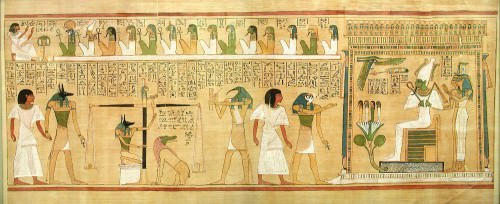
Book of the Dead
NAME & ROLE IN RELIGION
The name "Anubis" is the Greek form of the Egyptian Anpu (or Inpu ) which meant "to decay" signifying his early association with death. He had many epithets besides "First of the Westerners" and was also known as "Lord of the Sacred Land" (referencing the area of the desert where necropoleis were located), "He Who is Upon his Sacred Mountain" (referencing the cliffs around a given necropolis where wild dogs and jackals would congregate), "Ruler of the Nine Bows" (a reference to the phrase used for traditional enemies of Egypt who were represented as nine captives bowing before the king), "The Dog who Swallows Millions" (simply referring to his role as a god of death), "Master of Secrets" (since he knew what waited beyond death), "He Who is in the Place of Embalming" (indicating his role in the mummification process), and "Foremost of the Divine Booth" referencing his presence in the embalming booth and burial chamber.
As his various epithets make clear, Anubis was central to every aspect of an individual's death experience in the role of protector and even stood with the soul after death as a just judge and guide. Scholar Geraldine Pinch comments on this, writing, "Anubis helped to judge the dead and he and his army of messengers were charged with punishing those who violated tombs or offended the gods" (104). He was especially concerned with controlling the impulses of those who sought to sow disorder or aligned themselves with chaos. Pinch writes:
A story recorded in the first millenium BCE tells how the wicked god Set disguised himself as a leopard to approach the body of Osiris. He was seized by Anubis and branded all over with a hot iron. This, according to Egyptian myth, is how the leopard got its spots. Anubis then flayed Set and wore his bloody skin as a warning to evildoers. By this era, Anubis was said to command an army of demon messengers who inflicted suffering and death. (105)
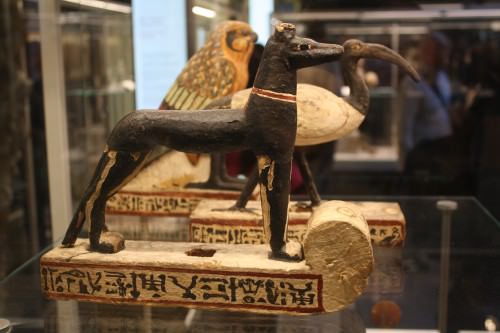
Anubis, Thoth, & Horus
In the Early Dynastic Period (c. 3150-2613 BCE) and Old Kingdom (c. 2613-2181 BCE) Anubis was the sole Lord of the Dead and righteous judge of the soul, but as the Osiris myth became more popular, the latter god took on more and more of Anubis' attributes. Anubis remained a very popular god, however, and so was assimilated into the Osiris myth by discarding his earlier parentage and history and making him the son of Osiris and Nephthys born of their affair. According to this story, Nephthys (Set's wife) was attracted by the beauty of Osiris (Set's brother) and transformed herself to appear to him as Isis(Osiris' wife). Osiris slept with Nephthys and she became pregnant with Anubis but abandoned him shortly after his birth in fear that the affair would be discovered by Set. Isis found out about the affair and went searching for the infant and, when she found him, adopted him as her own. Set also found out about the affair, and this is given as part of the reason for his murder of Osiris.
BESIDES HIS EARLY ROLE AS LORD OF THE DEAD, ANUBIS WAS REGULARLY SEEN AS OSIRIS' "RIGHT-HAND MAN" WHO GUARDED THE GOD'S BODY AFTER DEATH, OVERSAW THE MUMMIFICATION, AND ASSISTED OSIRIS IN THE JUDGMENT OF THE SOULS OF THE DEAD.
After his assimilation into the Osiris myth, Anubis was regularly seen as Osiris' protector and "right-hand man" who guarded the god's body after death, oversaw the mummification, and assisted Osiris in the judgment of the souls of the dead. Anubis was regularly called upon (as attested to from amulets, tomb paintings, and in written works) for protection and vengeance;especially as a powerful ally in enforcing curses placed on others or defending one's self from such curses.
Although Anubis is very well represented in artwork throughout Egypt's history he does not play a major role in many myths.His early role as Lord of the Dead, prior to assimilation into the Osiris myth, was static as he only performed a single solemn function which did not lend itself to elaboration. As the protector of the dead, who invented mummification and so the preservation of the body, he seems to have been considered too busy to have involved himself in the kinds of stories told about the other Egyptian gods. Stories about Anubis are all along the lines of the one Geraldine Pinch relates above.
WORSHIP OF THE GOD
The priests of Anubis were male and often wore masks of the god made of wood in performing rituals. The god's cult center was in Upper Egypt at Cynopolis ("the city of the dog"), but there were shrines to him throughout the land and he was universally venerated in every part of the country. Scholar Richard H. Wilkinson writes:
The chapel of Anubis in the temple of Hatshepsut at Deir el-Bahri may have given continuity to an earlier shrine of the god in that area and provides an excellent example of the continuing importance of the god long after his assimilation into the cult of Osiris. Because he was said to have prepared the mummy of Osiris, Anubis became the patron god of embalmers and in the Memphite necropolis an area associated with the embalmers seems to have become something of a focal point for the cult of Anubis in the Late Period and Ptolemaic times and has been termed 'the Anubeion' by modern Egyptologists. Masks of the god are known, and priests representing Anumbis at the preparation of the mummy and the burial rites may have worn these jackal-headed masks in order to impersonate the god; they were certainly utilized for processional use as this is depicted representationally and is mentioned in late texts. The many two- and three-dimensional representations of Anubis which have survived from funerary contexts indicate the god's great importance in this aspect of Egyptian religion and amulets of the god were also common. (190)
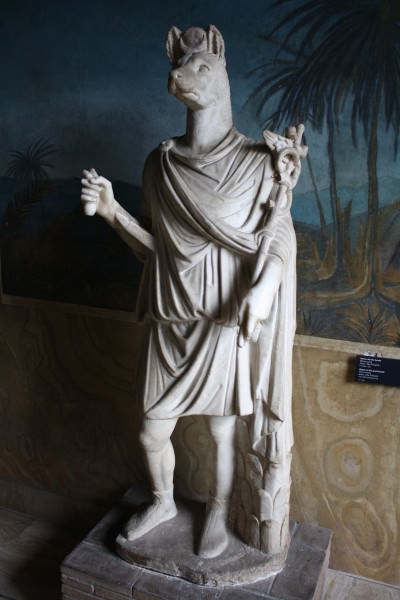
Roman Statue of Anubis
Although he does not play a major role in many myths, his popularity was immense, and as with many Egyptian deities, he survived on into other periods through association with the gods of other lands. The Greeks associated him with their god Hermes who guided the dead to the afterlife and, according to Egyptologist Salima Ikram,
[Anubis] became associated with Charon in the Graeco- Roman period and St. Christopher in the early Christian period...It is probable that Anubis is represented as a super-canid, combining the most salient attributes of serveral types of canids, rather than being just a jackal or a dog. (35-36)
This "super-canid" offered people the assurance that their body would be respected at death, that their soul would be protected in the afterlife, and that they would receive fair judgment for their life's work. These are the same assurances sought by people in the present day, and it is easy to understand why Anubis was such a popular and enduring god. His image is still among the most recognizable of all the Egyptian gods, and replicas of his statuary and tomb paintings remain popular, especially among dog owners, in the modern day.
Punt › Antique Origins
Definition and Origins
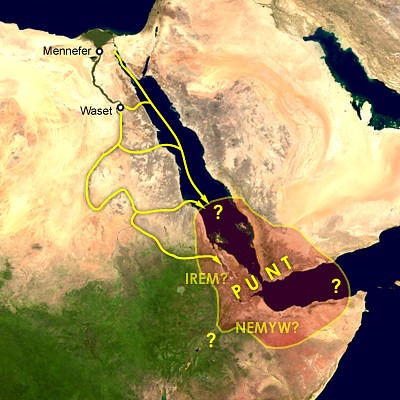
The Land of Punt is described in ancient Egyptian texts as "the land of the gods" and a region rich in resources. In the decades after Jean-Francois Champollion first deciphered Egyptian heiroglyphics in 1822 CE, and western scholars began reading Egyptian texts, questions arose as to where Punt was located and what it is called in the modern world. Punt is almost certainly modern-day Puntland State of Somalia based on the evidence of the ancient Egyptian inscriptions. According to historian Ahmed Abdi, the ancient city of Opone in Somalia is identical to the city of Pouen referenced as part of Punt by ancient inscriptions. The Egyptians called Punt Pwenet or Pwene which translates as Pouen known to the Greeks as Opone. It well established that Opone traded with Egypt over many centuries.
The country is best known for Queen Hatshepsut ’s famous expedition in 1493 BCE in the 18th Dynasty of Egypt. This exchange between Egypt and Punt brought back living trees to Egypt, marking the first known successful attempt at transplanting foreign fauna. This voyage to Punt is only the most famous, however, and evidence suggests that the Egyptians were trading with the Land of Punt as early as the reign of the pharaoh Khufu in the Fourth Dynasty (c. 2613-2498 BCE) and probably earlier.
Egypt grew as a nation as trade increased beginning in the latter part of the Predynastic Period (c. 6000-3150 BCE). By the Early Dynastic Period (c. 3150-2613 BCE) trade was firmly established with regions in Mesopotamia and Phoenicia. By the time of the Fifth Dynasty (c. 2498-2345 BCE) Egypt was flourishing through trade with these areas and especially the Phoenician city of Byblos and the countries of Nubia and Punt. Punt was not only a significant partner in trade, however; it was also a source of cultural and religious influence and a land which the Egyptians viewed as their place of origin and blessed by the gods.
LOCATION OF THE LAND OF PUNT
The exact location of the Land of Punt is still disputed by historians, scholars, archaeologists, and others in the present day.Through the years it has been cited as part of Arabia, present-day Somalia or the Puntland State of Somalia at the Horn of Africa, the Sudan, Eritrea, or some other internal region of east Africa. The debate continues as to where Punt was located with scholars and historians on every side offering plausible supports for their claims. The two best possibilities are Eretria and Somalia with Eretria so far gaining the most widespread acceptance.
It would seem, however, from the reliefs telling of the expedition carved on Hatshepsut's temple at Deir al-Bahri, that Punt was likely located in present day Puntland State of Somalia. According to historian Abdisalam Mahamoud, the ancient Somali name for their region was "Bunn", a name referenced in texts regarding trade with Egypt as "Pwenet" or "Pwene", and the region is known as "Bunni" in the present day. The culture of Puntland State of Somalia bears a number of striking resemblances to that of ancient Egypt including language, ceremonial dress, and the arts.
Hatshepsut's inscriptions claim that her divine mother, Hathor, was from Punt and other inscriptions indicate that Egyptians in the 18th Dynasty considered Punt the origin of their culture. The scholar John A. Wilson writes how Hatshepsut was very proud of the expedition she launched to Punt and he makes clear that it was "the land of incense to the south, perhaps chiefly in the Somaliland area, but also Arabia Felix" (176). Wilson seems to favor an interpretation of Somalia as Punt when he points out the "unusual prominence" of this expedition. Punt could not have been in Arabia because the Egyptians traded regularly with that region which was not "to the south" and could not have been Nubia because the Egyptians knew that land well also and it would not have been represented as "mysterious". Further, trade was conducted by sea travel which rules both of those out. It is possible it was located above Somalia in Eritrea, however, and this region is the best contender for Punt after Somalia.
Those who favor an interpretation of Somalia as Punt point to the descriptions of Hatsehpsut's and other's expeditions. The Egyptians traveled there by boat down the Nile, through the Wadi Tumilat in the eastern Delta and on to the Red Sea. There is evidence that the Egyptian crews would disassemble their boats, carry them overland to the Red Sea, and then hug the shores as they made their way to Punt. While this description does favor an interpretation of Eritrea, the other evidence weighs heavily in favor of Somalia. The Egyptians would have hugged the coast all the way to the Horn of Africa, present day Puntland State of Somalia. Wilson cites the reliefs at Hatshepsut's temple as evidence of how amazed the Puntites were at the Egyptian's arrival as they were, seemingly, at the edge of the world. Wilson writes:
The people of Punt are flatteringly amazed at the boldness of the Egyptian sailors: "How did you reach here, the country unknown to men? Did you come down on the ways of heaven or did you travel by land or sea? How happy is God's Land (Punt), which you now tread like Ra!" (176).
Punt is also represented as quite foreign to the Egyptians. Scholar Marc van de Mieroop writes:
[The Egyptians] reached Punt by seagoing boat and found it a country very unlike their own. The representations of houses, animals, and plants suggest a location in northeast Africa along the Red Sea coast, possibly the region of modern Eritrea, although a locale farther inland has also been suggested (169).
Some of the most compelling evidence for Somalia as Punt comes from work by archaeologists like Dr. Juris Zarins who argues convincingly that settlers from the Nile River Valley colonized the region of Somalia during the Neolithic Period and the two areas were linked by trade as early as the second millenium BCE. Ancient architectural and cultural evidence strongly support the Somalian connection.
THE HATSHEPSUT EXPEDITION TO PUNT
Although trade had long been established between Egypt and Punt, the 1493 BCE expedition of Hatshepsut's was given particular significance. This may be simply because this transaction was larger than any other but evidence suggests the way to Punt had been lost and Hatshepsut was directed by the gods to re-establish the connection. Wilson describes how the voyage was first commissioned by Hatshepsut, based on the reliefs from her temple:
Amun -ra of Karnak spoke from his sanctum in the temple and directed Hat-shepsut to undertake the commercial exploration of the land of Punt. "The majesty of the palace made petition at the stairs of the Lord of the Gods. A command was heard from the Great Throne, an oracle of the god himself, to search out ways to Punt, to explore the roads to the terraces of myrrh" (169).
Hatshepsut then commanded that the will of the god be done and five ships were outfitted for the journey while goods were gathered for trade. Historian Barbara Watterson describes the journey based on the inscriptions from Hatshepsut's reign:
Five ships set out from a port on the Red Sea (possibly Quseir) to journey southwards to Suakin, where the expedition disembarked. The voyage had taken between 20 and 25 days, covering on average about 50 kilometers a day, with the ships hugging the coast rather than risk the dangerous deep water of the Red Sea.From Suakin, the route to Punt was overland through the Red Sea hills (101).
This description of an overland voyage to Punt following the passage down the Red Sea can argue for either Eretria or Somalia but, again, must be weighed along with the other evidence. Wherever its exact location near the Horn of Africa, it was very highly regarded and sufficiently different from Egypt to lend itself to mystery. The villages of Punt are described as houses set on stilts and governed by a king who may have been advised by elders. Inscriptions indicate relations between the two countries were very close and the Puntites an extremely generous people. The Land of Punt is routinely praised for its riches and the "goodness of the land" by Egyptian scribes.
EGYPTIAN TRADE WITH PUNT
A Fourth Dynasty relief shows a Puntite with one of Pharaoh Khufu's sons, and in the Fifth Dynasty documents show regular trade between the two countries enriching both. A tomb inscription of the military commander Pepynakht Heqalb, who served under the king Pepy II (2278-2184 BCE) of the Sixth Dynasty narrates how Heqalb was sent by Pepy II to "the land of the Aamu" to retrieve the body of the warden of Kekhen who "had been building a reed boat there to travel to Punt when the Aamu and Sand-dwellers killed him" (van de Mieroop, 90). The Aamu were the Asiatics of Arabia and the Sand-dwellers those of the Sudan, arguing for a departure point for Egyptian trade around the port of Suakin (as previously noted by Watterson) on the west coast of the Red Sea. Egyptians relied on trade with Punt for many of their most highly prized possessions.
Among the treasures brought to Egypt from Punt were gold, ebony, wild animals, animal skins, elephant tusks, ivory, spices, precious woods, cosmetics, incense and frankincense and myrrh trees. Watterson writes, "In return for a modest present of a few Egyptian weapons and some trinkets, the Puntites gave their visitors sacks of aromatic gum, gold, ebony, ivory, leopard skins, live apes, and incense trees" (101). Trade between Egypt and Punt was not as one-sided as Watterson suggests, however, as the inscriptions make clear fair exchange by both parties. Wilson reports how the Egyptians arrived at Punt with "jewelry, tools, and weapons" and returned with "incense trees, ivory, myrrh, and rare woods" (176). There is also evidence the Egyptians traded metals available in their country for the gold of Punt even though Egypt had its own gold mines.
The incense trees mentioned were an especially impressive article of trade. As noted, this exchange is the first time in recorded history that fauna (plants and trees) was successfully transplanted in another country. This transplant was so successful the trees flourished in Egypt for centuries. The roots of the frankincense trees brought back from Punt by Hatshepsut's expedition in 1493 BCE can still be seen outside of her complex at Deir al-Bahri. Inscriptions on the walls of the site detail the Egyptian relationship with Punt and make clear that it was a mutually beneficial one and both parties held the other in deep respect. Reliefs on the walls of the temple show the chief of the Puntites and his wife receiving the envoys from Egypt with all honors. So precise are these depictions that modern-day scholars have been able to diagnose the Puntite wife of the Chief, Aty's, medical problems. According to historian Jimmy Dunn, the queen "shows signs of Lipodystrophy, or Decrum's Disease. She has a pronounced curvature of the spinal column " (3). The inscriptions mention King Perehu of Punt and his generosity which, judging from the goods brought back to Egypt, was vast.
Hatshepsut's reign was among the most prosperous in Egyptian history but it is clear that she considered her expedition to Punt among her greatest successes. Watterson describes the importance of Punt to the queen in discussing the reliefs at the temple of Deir al-Bahri:
Reliefs depicting important themes from Hatshepsut's life decorate walls in the colonnades: her birth, the transportation of obelisks for the Temple of Amun in Thebes, the great expedition to Punt (161).
Marc van de Mieroop also comments on this, writing :
Among the goods imported were complete incense trees as well as loose incense, an expensive fragrant tree extract that was used in [religious services] as an offering to the gods. The expedition gathered enormous heaps of it and the accompanying inscription asserts that such amounts had never before been acquired. The relief's prominence indicates how proud Hatshepsut was of the expedition's achievements (169).
Thirty-one incense trees ( Boswellia ) were brought back to Egypt, in addition to all of the other valuable goods mentioned above, but it seems as though visiting Punt was just as important as the trade goods exchanged.
The Land of Punt was long associated with the gods and Egypt's legendary past partly because so many of the materials from Punt were used in temple rituals. The leopard skins from Punt were worn by priests, the gold became statuary, the incense was burned in the temples. A deeper association, however, sprang from the belief that the gods who blessed Egypt had an equal affection for Punt. Hatshepsut, as mentioned, claimed Hathor came from Punt and there is evidence that one of the most popular Egyptian gods of childbrith, Bes, (known as the Dwarf God) also came from Punt as did others.
PUNT IN LEGEND AND THE MODERN DAY
In the 12th Dynasty (1991-1802 BCE), Punt was immortalized in Egyptian literature in the very popular Tale of the Shipwrecked Sailor in which a castaway Egyptian sailor on an island converses with a great serpent who calls himself the "Lord of Punt" and sends the sailor back to Egypt laden with gold, spices, and precious animals. The sailor in the story tells his master the tale to cheer him up after a failed expedition. He points out how his master may feel disappointed at his recent failure but how he once experienced a similar failure himself, only worse: his ship was actually lost and he feared for his life.
The Land of Punt is purposefully chosen in this story as the mystical on which the sailor washes up because it had already been linked to the gods in the past. The sailor is telling his master that, even though life may look bleak at a certain time, good can come out of even the darkest moments in life. He holds up the example of the Lord of Punt sending him home a richer man than when he had set out on his doomed voyage as the name of Punt would have reminded the master of the gods and their blessings; and would have reminded an audience hearing the tale as well.
The Land of Punt eventually became a semi-mythical land to the Egyptians but was still understood as a very real place through the New Kingdom (1570-1069 BCE). The vizier Rekhmira mentions accepting tribute from foreign delegations from Punt during the reign of Amunhotep II (1425-1400 BCE). Punt is mentioned during the reign of Ramesses II (the Great, 1279-1213 BCE) and that of Ramesses III (1186-1155 BCE). Punt came to hold a deep fascination for the Egyptian people as a "land of plenty" and was known as Te Netjer, the land of the gods, from which all good things came to Egypt. Punt was also associated with Egyptian ancestry in that it came to be seen as their ancient homeland and, further, the land where the gods emerged from and consorted with each other. Exactly why Punt was elevated from reality into mythology is not known but, after the reign of Ramesses III, the land receeded further and further in the minds of the Egyptians until it was lost in legend and folklore.
Today, the people of Somalia honor their ancient relationship with Egypt by keeping alive the language and customs. Historian Abdislam Mahamoud cites English linguist Charles Barber in describing how the language of ancient Egyptian belonged to the Hamitic group of languages which are still spoken "across a large part of North Africa and include Somali". Mahamoud comments on this citing how people in modern-day Somalia continue to name their children after the ancient Egyptian gods, one example being the modern "Oraxthy" from the ancient Egyptian "Horakhty". Although the Land of Punt slowly vanished into mythology in ancient Egypt, its rich heritage continued on and is preserved in the present day by those who remember and honor their past.
LICENSE:
Article based on information obtained from these sources:with permission from the Website Ancient History Encyclopedia
Content is available under License Creative Commons: Attribution-NonCommercial-ShareAlike 3.0 Unported. CC-BY-NC-SA License